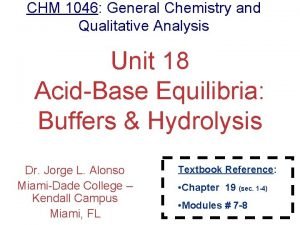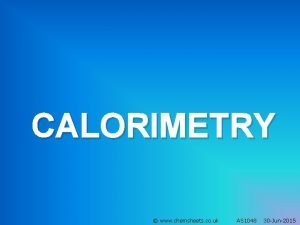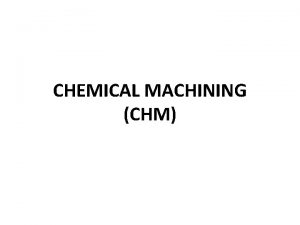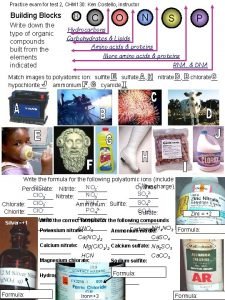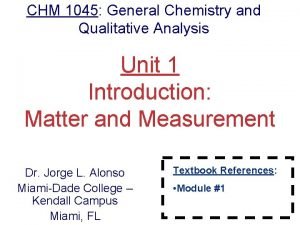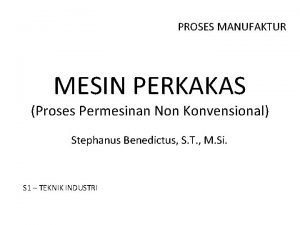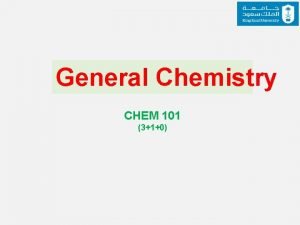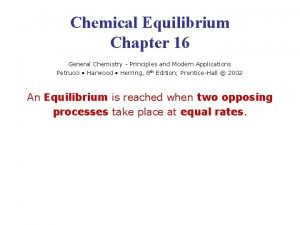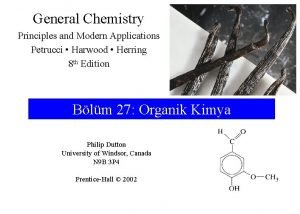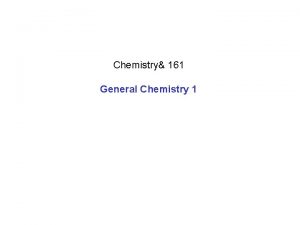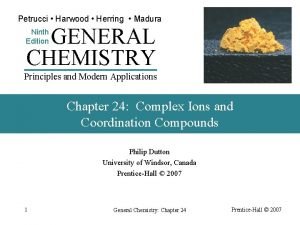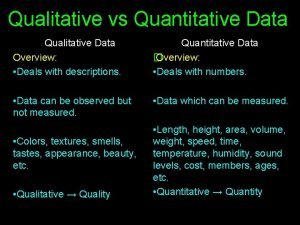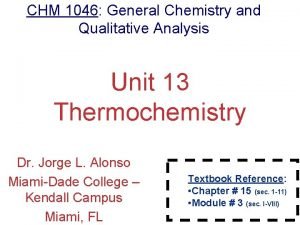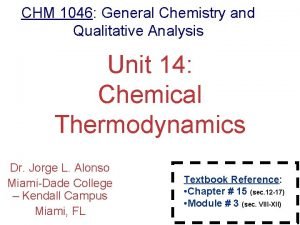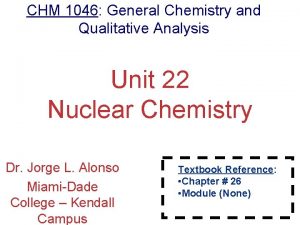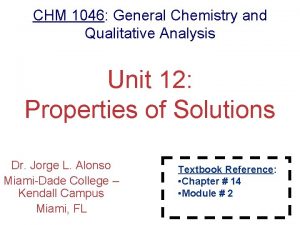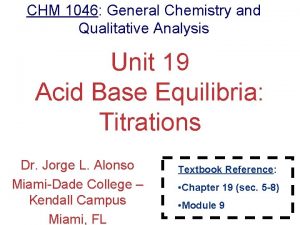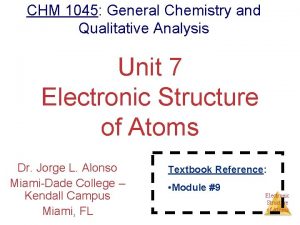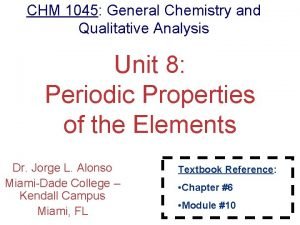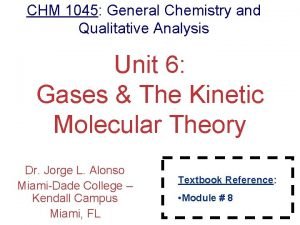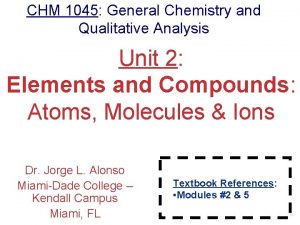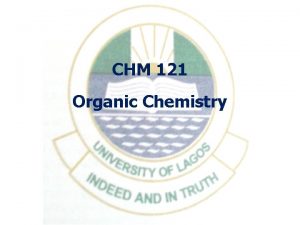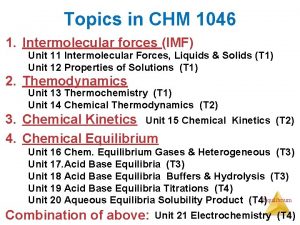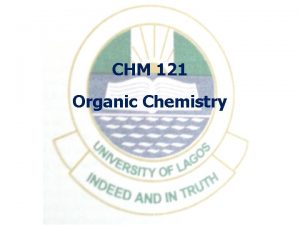CHM 1046 General Chemistry and Qualitative Analysis Unit



![The Common-Ion Effect [H 3 O+] [F−] Ka = [HF] = X= What is The Common-Ion Effect [H 3 O+] [F−] Ka = [HF] = X= What is](https://slidetodoc.com/presentation_image_h/10107fdafcc87f41217a1f0b99227693/image-4.jpg)

![[ ] Acids and Bases [ ] Acids and Bases](https://slidetodoc.com/presentation_image_h/10107fdafcc87f41217a1f0b99227693/image-6.jpg)

![Add base (OH-) Buffers [HF] + H 2 O OH- + HF H 2 Add base (OH-) Buffers [HF] + H 2 O OH- + HF H 2](https://slidetodoc.com/presentation_image_h/10107fdafcc87f41217a1f0b99227693/image-8.jpg)



![[ ] Ka = [ ] [H 3 O+] [A−] [HA] [base] p. H [ ] Ka = [ ] [H 3 O+] [A−] [HA] [base] p. H](https://slidetodoc.com/presentation_image_h/10107fdafcc87f41217a1f0b99227693/image-12.jpg)
![p. H= p. Ka + log [base] [acid] Acids and Bases p. H= p. Ka + log [base] [acid] Acids and Bases](https://slidetodoc.com/presentation_image_h/10107fdafcc87f41217a1f0b99227693/image-13.jpg)

![Addition of Strong Acid or Base to a Buffer Add base (OH-) [HA] + Addition of Strong Acid or Base to a Buffer Add base (OH-) [HA] +](https://slidetodoc.com/presentation_image_h/10107fdafcc87f41217a1f0b99227693/image-15.jpg)






















- Slides: 37

CHM 1046: General Chemistry and Qualitative Analysis Unit 18 Acid-Base Equilibria: Buffers & Hydrolysis Dr. Jorge L. Alonso Miami-Dade College – Kendall Campus Miami, FL Textbook Reference: • Chapter 19 (sec. 1 -4) • Modules # 7 -8 Acids and Bases

The Common-Ion Effect A solution composed of two substances, each containing a same ion in common. One is a weak electrolyte (equilibrium) the other strong(not equil). Examples: (1) HF(aq) + Na. F(s) (2) HC 2 H 3 O 2(aq) + Na. C 2 H 3 O 2 (s) Add strong electrolyte (3) HF(aq) + HCl (aq) Consider a solution of acetic acid, a weak electrolyte: HC 2 H 3 O 2 (aq) + H 2 O (l) Na. C 2 H 3 O 2 H 3 O+ (aq) + C 2 H 3 O 2− (aq) What will Le Châtelier predict will happen to the equilibrium? It will shift to the left. “The extent of ionization of a weak electrolyte is decreased. Acids by adding to the solution a strong electrolyte that has an ion inand Bases common with the weak electrolyte. ”

The Common-Ion Effect Problem: Calculate the fluoride ion concentration and p. H of a solution that is 0. 20 M in HF and 0. 10 M in HCl. Ka for HF is 6. 8 10− 4. HF(aq) + H 2 O(l) H 3 O+(aq) + F−(aq) Because HCl, a strong acid, is also present, the initial [H 3 O+] is not 0, but rather 0. 10 M. [H 3 O+] [F−] = 6. 8 10 -4 Ka = [HF] Initially Change At Equilibrium [HF], M 0. 20 −x 0. 20 − x 0. 20 [H 3 O+], M 0. 10 +x 0. 10 + x 0. 10 [F−], M 0 Acids +x and x. Bases
![The CommonIon Effect H 3 O F Ka HF X What is The Common-Ion Effect [H 3 O+] [F−] Ka = [HF] = X= What is](https://slidetodoc.com/presentation_image_h/10107fdafcc87f41217a1f0b99227693/image-4.jpg)
The Common-Ion Effect [H 3 O+] [F−] Ka = [HF] = X= What is [F−] ? And p. H? (0. 10+x) (x) = (0. 20 -x) (0. 20) (6. 8 10− 4) (0. 10) 6. 8 10− 4 x = 1. 4 10− 3 Therefore, [F−] = x = 1. 4 10− 3 [H 3 O+] = 0. 10 + x = 0. 10 + 1. 4 10− 3 = 0. 10 M • So, p. H = −log (0. 10) p. H = 1. 00 Acids and Bases

Acids and Bases
![Acids and Bases [ ] Acids and Bases](https://slidetodoc.com/presentation_image_h/10107fdafcc87f41217a1f0b99227693/image-6.jpg)
[ ] Acids and Bases

Buffers • Solutions that are particularly resistant to p. H changes, even when strong acid or base is added. • Buffers are solutions of a weak acid mixed with a salt of its conjugate base (a weak conjugate acidbase pair solution). i. e. , acetic acid + sodium acetate [ HC 2 H 3 O 2(aq)] + H 2 O(l) H 3 O+(aq) +[C 2 H 3 O 2−Acids (aq)] Which is less acidic, buffer (WA + Salt of c. base) or same conc. of weak acid alone? and Bases
![Add base OH Buffers HF H 2 O OH HF H 2 Add base (OH-) Buffers [HF] + H 2 O OH- + HF H 2](https://slidetodoc.com/presentation_image_h/10107fdafcc87f41217a1f0b99227693/image-8.jpg)
Add base (OH-) Buffers [HF] + H 2 O OH- + HF H 2 O + F- If an acid is added, the F− reacts with H+ to form HF and water. Add acid (H 3 O+) H 3 O+ + [F- ] HF H 3 O+ + F- If a hydroxide is added to an Acids equimolar solution of HF in Na. F, and for example, the HF reacts with Bases − − the OH to make F and water.

p. H of Buffer Calculations: The Henderson–Hasselbalch Equation For the dissociation of a generic acid, HA: +] [A−] [H O 3 HA + H 2 O H 3 O + + A − K a = [HA] Rearranging slightly, this becomes −] [A Ka = [H 3 O+] [HA] Taking the negative log of both side, we get −] [A −log Ka = −log [H 3 O+] + −log [HA] [base] p. Ka = p. H − log [acid] Rearranging, this becomes [base] p. H = p. Ka + log [acid] Henderson–Hasselbalch Equation. Acids and Bases

Henderson–Hasselbalch Equation Problem: What is the p. H of a buffer that is 0. 12 M in lactic acid, HC 3 H 5 O 3, and 0. 10 M in sodium lactate? Ka = 1. 4 10− 4. [H 3 O+] [A−] Ka = [HA] [base] p. H = p. Ka + log [acid] p. H = −log (1. 4 10− 4) (0. 10) + log (0. 12) p. H = 3. 85 + (− 0. 08) p. H = 3. 77 Acids and Bases

p. H Range of Buffers Systems p. Ka 3. 3. 4. 7. 9. 9. • The p. H range is the range of p. H values over which a buffer system works effectively. [base] p. H = p. Ka + log [acid] [1 M] p. H = p. Ka + log [1 M] p. H = p. Ka • It is best to choose an Acids acid with a p. Ka close andto Bases the desired p. H.
![Ka H 3 O A HA base p H [ ] Ka = [ ] [H 3 O+] [A−] [HA] [base] p. H](https://slidetodoc.com/presentation_image_h/10107fdafcc87f41217a1f0b99227693/image-12.jpg)
[ ] Ka = [ ] [H 3 O+] [A−] [HA] [base] p. H = p. Ka + log [acid] Acids and Bases
![p H p Ka log base acid Acids and Bases p. H= p. Ka + log [base] [acid] Acids and Bases](https://slidetodoc.com/presentation_image_h/10107fdafcc87f41217a1f0b99227693/image-13.jpg)
p. H= p. Ka + log [base] [acid] Acids and Bases

When Strong Acids or Bases Are Added to a Buffer… You end up with two problems: (1) an acid base neutralization, and (2) an equilibrium problem Strong base (OH-) [HX] + H 2 O Strong acid (H 3 O+) H 3 O+ + [X−] Acids and Bases
![Addition of Strong Acid or Base to a Buffer Add base OH HA Addition of Strong Acid or Base to a Buffer Add base (OH-) [HA] +](https://slidetodoc.com/presentation_image_h/10107fdafcc87f41217a1f0b99227693/image-15.jpg)
Addition of Strong Acid or Base to a Buffer Add base (OH-) [HA] + H 2 O Add some OH- What are the new equilibrium conc. after acid or base is added? Add some H 3 O + Add acid (H 3 O+) H 3 O+ + [A−] (HA + OH- A- + H 2 O) (H 3 O+ + A- HA + H 2 O) (1) Neutralization is NOT an equilibrium reaction. (2) However, it affects the amounts of the weak acid [HA] and its conjugate base [A-] left over, and a new equilibrium will be established. (1) Use: Mole ICEnd Table: *used for neutralization Rx* HA A- H 3 O+ or OH- η η +η Change (H 3 O+ or OH-) +η +η -η End (after)reaction η η 0η Mole (η) Initially Moles (η) Molarity (η/L) For a buffer: (2) p. H [base] = p. Ka + log [acid] Acids and Bases

Calculating p. H Changes in Buffers Problem: A buffer is made by adding 0. 300 mol HC 2 H 3 O 2 and 0. 300 mol Na. C 2 H 3 O 2 to enough water to make 1. 00 L of solution. The p. H of the buffer is 4. 74. Calculate the p. H of this solution after 0. 020 mol of Na. OH is added. HC 2 H 3 O 2(aq) + OH−(aq) C 2 H 3 O 2−(aq) + H 2 O(l) [base] = p. Ka + log [acid] Before the reaction, since p. H mol HC 2 H 3 O 2 = mol C 2 H 3 O 2− p. H = p. Ka = −log (1. 8 10− 5) = 4. 74 The 0. 020 mol Na. OH will react with 0. 020 mol of the acetic acid: Use: Mole ICEnd Table: *used for neutralization Rx* Mole Initially Change End (after) reaction HC 2 H 3 O 2 0. 300 η - 0. 020 η 0. 280 η C 2 H 3 O 2− 0. 300 η + 0. 020 η 0. 320 η OH− 0. 020 η - 0. 020 η 0. 000 η Acids and Bases

Calculating p. H Changes in Buffers Mole Initially Change End (After) reaction HC 2 H 3 O 2 0. 300 η - 0. 020 η 0. 280 η C 2 H 3 O 2− 0. 300 η + 0. 020 η 0. 320 η OH− 0. 020 η - 0. 020 η 0. 000 η Now use the Henderson–Hasselbalch equation to calculate the new p. H: [base] p. H = p. Ka + log [acid] (0. 320) p. H = 4. 74 + log (0. 280) p. H = 4. 74 + 0. 058 p. H = 4. 80 Acids and Bases

Acids and Bases

Hydrolysis hydro = water Module 8 lysis = breaking down Electrochemistry (also called electrolysis or electrohydrolysis) 2 H 2 O elect. 2 H 2 + O 2 Organic/Biochemistry (enzymatic splitting of organic molecules by using water) hydrolysis dehydration synthesis Acid Base Chemistry (splitting water by cations or anions to form acidic or basic solutions. Acids Cation+ + HOH Cation. OH + H+ Anion- + HOH HAnion + OH- and Bases

The Acid-Base Properties of Salt Solutions and Hydrolysis Salt (Ionic Compound) = Metal + Nonmetal = Cation+ + Anion. Hydrolysis: splitting water by cations or anions to form acidic or basic solutions Cations of Weak Bases Cation+ + HOH Al 3+ Anion- Anions of Weak Acids + H+ Cation. OH Al 3+ + HOH HAnion + OH- Acids and Bases

conjugate The Effect of Anions • An anion that is the conjugate base of a strong acid will not affect the p. H. • An anion that is the conjugate base of a weak acid will increase the p. H (behave Acids as bases). and Bases

Effect of Cations • Cations of the strong bases will not affect the p. H SOLUBILITY RULES: for Ionic Compounds (Salts) All OH- are insoluble, except for IA metals, NH 4+, Ca 2+, Ba 2+ , and Sr 2+ (heavy IIA). • Cations of a weak bases will lower the p. H (behave as acids) Acids and Bases • Greater charge and smaller size make a cation more acidic.

Ka of Weak Acid and Kb of its Conjugate Base The Ka of an acid and Kb of its conjugate base are related in this way: Ka Kb = Kw Therefore, if you know one of them, you can calculate the other. Problem: Is Na. C 2 H 3 O 2 acidic or basic? Calculate its Ka or Kb. Ka Kb = Kw (1. 8 x 10 -5) Kb = (1. 0 x 10 -14) Acids (1. 0 x 10 -14) and -10 = 5. 6 x 10 Kb = Bases -5 (1. 8 x 10 )

Effect of Cations and Anions ANION CATION • Cations of the strong bases will not affect the p. H SOLUBILITY RULES: for Ionic Compounds (Salts) All OH- are insoluble, except for IA metals, NH 4+, Ca 2+, Ba 2+ , and Sr 2+ (heavy IIA). • Cations of a weak bases will lower the p. H (behave as acids) When a solution contains both the conjugate base of a weak acid and the conjugate acid of a weak base, the affect on p. H depends on the Ka and Kb values. Acids and Bases

Acids and Bases

Acids and Bases

Acidic and Basic Salts Acid Salts: salts of weak polyprotic acids. Are not necessarily acidic, but do neutralize bases. Examples: Acid Salt(s) HNO 3 Na. NO 3 ------ H 2 CO 3 Na. HCO 3 H 3 PO 4 Na 2 HPO 4 Na. H 2 PO 4 Basic Salts: salts of weak polyhydroxy bases. Are not necessarily basic, but do neutralize acids. Mg(OH) 2(s) {Milk of Magnesia} Fe(OH)3(s) Cr(OH) 3(s) Acids Solubility Rule: and + 2+ 2+ • All OH are insoluble except for IA metals, NH 4 & slightly soluble Ca Ba Bases & Sr 2+

Buffers can act as either…acids or bases…. . . they are amphiprotic Add acid H 3 O + OH H 2 O + H 3 PO 4 + . - ↔ HCO 3 (aq) ↔ CO + H O ↔ H 2 PO 4−(aq) ↔ HPO + H O ↔ OH + H O 2 (l) ↔ − H 2 O + H 2 CO 3 H 2 O + H 3 O Add base 3 2 - 4 Not a buffer accepts protons / donates protons - 2 2 Acids and Bases

2007 (B) Acids and Bases

Making Solution Molarity Acids and Bases

2007 B Q 5 Carboxylic acid Organic Acids: carboxylic acid functional group -COOH -COO- + H+ Acids and Bases

2005 A Q 1 Acids and Bases

Acids and Bases

Review of Strong Acid & Bases Strong acids have very weak conjugate bases HX + acid H 2 O base H 3 O + + conj. a X Has no affinity for H+ - conj. b Strong bases have very weak conjugate acids MOH M+ base conj. a + OH- Has no affinity for OH- conj. b Salts of Strong acids & bases have very weak conjugate acids & bases MX salt + H 2 O M+(aq) + conj. a Example: HCl X- (aq) conj. b Example: Na. OH Example: Na. Cl Have no Acids and affinity for Bases H+ or OH

Review of Weak Acid & Bases Weak acids (HA) have very strong conjugate bases (A-) HA + H 2 O ↔ H 3 O+ + AHas affinity acid base conj. a conj. b Example: HF Weak bases (B) have very strong conjugate acids (BH+) B + HOH ↔ BH+ + OHHas affinity base acids conj. a conj. b Example: NH 3 for H+ Salts: (1) of strong base & weak acid: MA M+(aq) + A-(aq) A- + HOH HA + OH- (hydrolysis) (2) of a weak base & strong acid: BHX BH+(aq) + X-(aq) BH+ + HOH B + H 3 O+ (hydrolysis) (3) of a weak base & weak acid: BHA ↔ BH+(aq) + A-(aq) for OH- Example: Na. F Example: NH 4 Cl Acids Example: and NH 4 F Bases

Reactions of Cations with Water • Cations with acidic protons (like NH 4+) will lower the p. H of a solution: NH 4+ + H 2 O H 3 O+ + NH 3 H O H • Most metal cations that are hydrated in solution also lower the p. H of the solution, acting as Lewis acids: Ø The attraction between nonbonding electrons on waters’ oxygen and the metal cation causes a shift of the electron density in water. Ø This makes the O-H bond more polar and the water more acidic. Greater charge and smaller size Acids and make a cation more acidic. Bases

conjugate The Effect of Cations Acids and Bases
 General chemistry with qualitative analysis
General chemistry with qualitative analysis Calorimetry 2 chemsheets answers as 1047
Calorimetry 2 chemsheets answers as 1047 Unit 6 review questions
Unit 6 review questions Qualitative analysis chemistry
Qualitative analysis chemistry Quantitative chemistry igcse
Quantitative chemistry igcse Chm 151 final exam
Chm 151 final exam Joenschem
Joenschem Etch factor in chemical machining
Etch factor in chemical machining Chm 130 chapter 12 practice problems answer key
Chm 130 chapter 12 practice problems answer key Chm 241
Chm 241 Chm 201
Chm 201 Chm 1045
Chm 1045 Chm 111
Chm 111 Chm machining
Chm machining Chm tool
Chm tool Chm logo
Chm logo Quantitative and qualitative in chemistry
Quantitative and qualitative in chemistry Ounce and pounds
Ounce and pounds Ib chemistry organic chemistry
Ib chemistry organic chemistry Inorganic chemistry vs organic chemistry
Inorganic chemistry vs organic chemistry Kind of quantitative research
Kind of quantitative research Data analysis qualitative and quantitative
Data analysis qualitative and quantitative Qualitative and quantitative data analysis
Qualitative and quantitative data analysis General chemistry thermochemistry
General chemistry thermochemistry General chemistry nomenclature
General chemistry nomenclature General chemistry 2
General chemistry 2 Organik kimya adlandırma öncelik sırası
Organik kimya adlandırma öncelik sırası General chemistry 11th edition
General chemistry 11th edition General chemistry 1 stoichiometry
General chemistry 1 stoichiometry General chemistry
General chemistry General chemistry
General chemistry General chemistry
General chemistry General chemistry
General chemistry General chemistry
General chemistry Diferencia entre gran plano general y plano general
Diferencia entre gran plano general y plano general Where did general lee surrender to general grant?
Where did general lee surrender to general grant? Holistic
Holistic Qualitative vs quantitative
Qualitative vs quantitative
